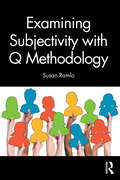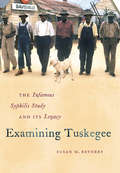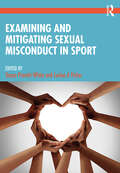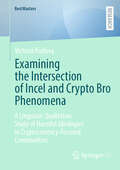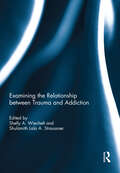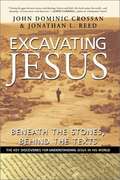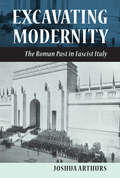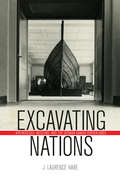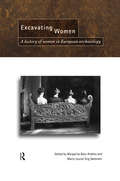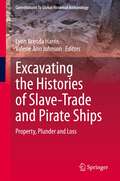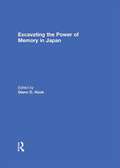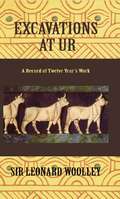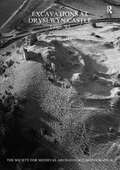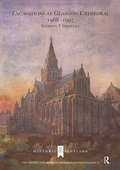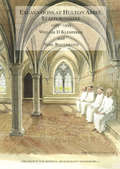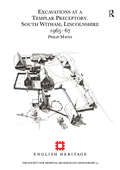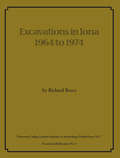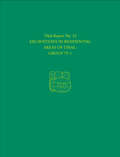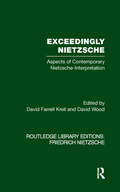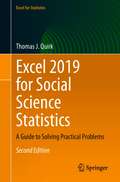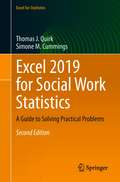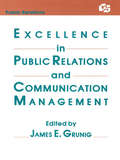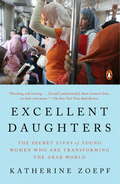- Table View
- List View
Examining Subjectivity with Q Methodology
by Susan RamloThis innovative book explores how Q methodology offers a unique way to examine subjectivity, meaning people’s viewpoints, in that it both differentiates and describes viewpoints, by blending qualitative and quantitative research methods. The book provides accurate terminology and consistent practices, with examples of using Q to study subjectivity in a variety of contexts and disciplines. The book also frames Q with its unique blending of qualitative and quantitative research aspects, from data collection to analysis and interpretation. The author aims to help readers to understand the basics of Q methodology as well as delving deeper into Q as explicated by William Stephenson in an easy to read yet accurate text in terms of processes and theoretical frameworks of Q.This is an essential text for those interested in using Q methodology in qualitative research and mixed methods research across a range of disciplines.
Examining Tuskegee
by Susan M. ReverbyThe forty-year "Tuskegee" Syphilis Study has becometheAmerican metaphor for medical racism, government malfeasance, and physician arrogance. The subject of histories, films, rumors, and political slogans, it received an official federal apology from President Bill Clinton in a White House ceremony. Susan M. Reverby offers a comprehensive analysis of the notorious study of untreated syphilis, which took place in and around Tuskegee, Alabama, from the 1930s through the 1970s. The study involved hundreds of African American men, most of whom were told by doctors from the U. S. Public Health Service that they were being treated, not just watched, for their late-stage syphilis. Reverby examines the study and its aftermath from multiple perspectives to explain what happened and why the study has such power in our collective memory. She follows the study's repercussions in facts and fictions. Reverby highlights the many uncertainties that dogged the study during its four decades and explores the newly available medical records. She uncovers the different ways it was understood by the men, their families, and health care professionals, ultimately revising conventional wisdom on the study. Writing with rigor and clarity, Reverby illuminates the events and aftermath of the study and sheds light on the complex knot of trust, betrayal, and belief that keeps this study alive in our cultural and political lives.
Examining and Mitigating Sexual Misconduct in Sport
by Tanya Prewitt-White Leslee A. FisherSexual Misconduct in any environment is a gross abuse of trust and this is no different within the sport world. Examining and Mitigating Sexual Misconduct in Sport outlines systemic and sociological explanations for why sport is a site of sexual misconduct. The authors in the text describe cultural realities and considerations sport stakeholders must acknowledge and be informed of to make sport a more equitable and safe space. Personal narratives from a variety of sport stakeholders, which unveil their lived experiences of sexual misconduct and humanize survivor stories in ways often ignored in sport and society, are shared. Authors offer recommendations to all sport stakeholders to mitigate incidents of and harm done by sexual misconduct. Guidelines and suggestions for sport stakeholder practices that better protect individuals in sport, address sexual misconduct when it occurs, and mitigate the harm and trauma experienced because of incidents of sexual misconduct are also examined and provided. This book is the first text of its kind to invite sport stakeholders to have open, vulnerable, and honest discussions around a timely topic often minimized, denied and/or ignored in sport. A ground-breaking new book, Examining and Mitigating Sexual Misconduct in Sport is key reading for any sport coach, sport parent, sport psychology professional, or sport administrator.
Examining the Intersection of Incel and Crypto Bro Phenomena: A Linguistic Qualitative Study of Harmful Ideologies in Cryptocurrency-Focused Communities (BestMasters)
by Victoria KozlovaThis book addresses the issue of gender underrepresentation in the cryptocurrency domain. This thesis attributes it to the presence of unwelcoming and hostile communities around it. Grounded in the frameworks of feminist technoscience and situated knowledge, this research explores the linguistic landscape of these communities. Employing observational netnography and keyword search methodologies, the utilisation of incel-specific linguistic repertoire in cryptocurrency-focused discussions is uncovered on platforms like Discord. While the mere use of these terms doesn't directly link cryptocurrency enthusiasts to the incel community, their widespread adoption and normalisation can perpetuate harmful stereotypes and discourage individuals who don't align with such ideologies from participating. The aim of this thesis is to raise awareness about potential barriers created by often questionable linguistic choices.
Examining the Relationship between Trauma and Addiction
by Shelly A. Wiechelt and Shulamith Lala A. StraussnerTrauma, trauma-related disorders, substance use, and addictive disorders often co-occur, and frequently play a role in the problems and issues that social workers contend with in their practice with individuals, families, and communities. Research shows that there is a relationship between trauma-related symptoms and problematic use of substances and other addictive behaviors. Individuals who experience these co-occurring problems have better outcomes when their issues are addressed with integrated treatment approaches. Trauma-informed care and trauma-specific treatment are therefore important components of effective social work interventions.This book examines various types of trauma, such as intergenerational trauma, adverse childhood events, childhood sexual abuse, and minority stress, amongst various populations and settings, including Native Americans, homeless youth, drug court participants, and LGB adolescents. It also explores the challenges in delivering trauma services in outpatient addiction treatment settings. Furthermore, it provides practical information on how to implement trauma-informed approaches in addiction treatment, and offers insights into the experience of a trauma survivor who is also recovering from a substance use disorder. This book was originally published as a special issue of the Journal of Social Work Practice in the Addictions.
Excavating Jesus: Beneath the Stones, Behind the Texts
by Jonathan L. Reed John Dominic CrossanJesus scholar and archeologist combine to look at life of Jesus.
Excavating Modernity: The Roman Past in Fascist Italy
by Joshua ArthursThe cultural and material legacies of the Roman Republic and Empire in evidence throughout Rome have made it the "Eternal City." Too often, however, this patrimony has caused Rome to be seen as static and antique, insulated from the transformations of the modern world. In Excavating Modernity, Joshua Arthurs dramatically revises this perception, arguing that as both place and idea, Rome was strongly shaped by a radical vision of modernity imposed by Mussolini's regime between the two world wars.Italian Fascism's appropriation of the Roman past-the idea of Rome, or romanità- encapsulated the Fascist virtues of discipline, hierarchy, and order; the Fascist "new man" was modeled on the Roman legionary, the epitome of the virile citizen-soldier. This vision of modernity also transcended Italy's borders, with the Roman Empire providing a foundation for Fascism's own vision of Mediterranean domination and a European New Order. At the same time, romanità also served as a vocabulary of anxiety about modernity. Fears of population decline, racial degeneration and revolution were mapped onto the barbarian invasions and the fall of Rome. Offering a critical assessment of romanità and its effects, Arthurs explores the ways in which academics, officials, and ideologues approached Rome not as a site of distant glories but as a blueprint for contemporary life, a source of dynamic values to shape the present and future.
Excavating Nations
by J. Laurence HareExcavating Nations traces the history of archaeology and museums in the contested German-Danish borderlands from the emergence of antiquarianism in the early nineteenth-century to German-Danish reconciliation after the Second World War. J. Laurence Hare reveals how the border regions of Schleswig-Holstein and Sønderjylland were critical both to the emergence of professional prehistoric archaeology and to conceptions of German and Scandinavian origins.At the center of this process, Hare argues, was a cohort of amateur antiquarians and archaeologists who collaborated across the border to investigate the ancient past but were also complicit in its appropriation for nationalist ends. Excavating Nations follows the development of this cross-border network over four generations, through the unification of Germany and two world wars. Using correspondence and site reports from museum, university, and state archives across Germany and Denmark, Hare shows how these scholars negotiated their simultaneous involvement in nation-building projects and in a transnational academic community.
Excavating Women: A History of Women in European Archaeology
by Marie Louise Stig Sørensen Margarita Díaz-AndreuArchaeologists are increasingly aware of issues of gender when studying past societies; women are becoming better represented within the discipline and are attaining top academic posts. However, until now there has been no study undertaken of the history of women in European archaeology and their contribution to the development of the discipline. Excavating Women discusses the careers of women archaeologists such as Dorothy Garrod, Hanna Rydh and Marija Gimbutas, who against all odds became famous, as well as the many lesser-known personalities who did important archaeological work. The collection spans the earliest days of archaeology as a discipline to the present, telling the stories of women from Scandinavia, Mediterranean Europe, Britain, France, Germany and Poland. The chapters examine women's contributions to archaeology in the context of other, often socio-political, factors that affected their lives. It examines issues such as women's increased involvement in archaeological work during and after the two World Wars, and why so many women found it more acceptable to work outside of their native lands. This critical assessment of women in archaeology makes a major contribution to the history of archaeology. It reveals how selective the archaeological world has been in recognizing the contributions of those who have shaped its discipline, and how it has been particularly inclined to ignore the achievements of women archaeologists. Excavating Women is essential reading for all students, teachers and researchers in archaeology who are interested in the history of their discipline and its sociopolitics.
Excavating the Histories of Slave-Trade and Pirate Ships: Property, Plunder and Loss (Contributions To Global Historical Archaeology)
by Lynn Brenda Harris Valerie Ann JohnsonThis edited volume brings new perspectives on the topic maritime archaeology of the slave trade in the Caribbean. The book focuses on shipwrecks of the slave trade in the 18th century and suggests that there is a more complex and challenging social narrative than has previously been discussed. The authors examine biographies of ships, crew members, voyage logs, cargo inventories, trader correspondence and contextual analysis of the artifact assemblages to bring new insights into the microeconomics and maritime traditions of these floating prisons. The illustrious biography of Captain Edward Thache (aka Blackbeard) reveals past identities as a naval officer, slave trader, and pirate. Categories of artifacts in archaeological collections represent cultural connections and traditions of enslaved Africans. The volume includes several case studies that inform these narratives and examines slave ships such as la Concorde, Henrietta Marie, Whydah, La Marie Seraphique and Marquis de Bouillé. Within the larger context of slave trade during the 18th century, authors explore legal and illegal trade in the British West Indies. These studies also address the plethora of social, political, and environmental impacts on these island communities that played an integral and strategic role in slave trade economics. This volume presents up-to-date research of professional maritime historians, artifact curators, and marine archaeologists drawing upon primary source documents, artwork, and material culture. The research collaborators reconstruct the international spheres of colonial North America, Europe, Africa, and West Indies. It is an interwoven narrative, both unique and typical, to the social and economic dynamics of 18th century Atlantic World.
Excavating the Land of Jesus: How Archaeologists Study the People of the Gospels
by James Riley StrangeHow do archaeologists unearth the daily life of people from Jesus&’s time?Contrary to popular belief, archaeology of first-century Roman Galilee is not about illustrating or proving the gospels, drawing timelines, or hunting treasure. Rather, it is about understanding the lives of people, just like us, who lived in the time of Jesus. How do we conceive of Jesus and his mission as part of a larger world? How did different groups in Roman Galilee understand their identities and values? How do we interpret material culture in conjunction with textual evidence from the gospels? On a more basic level, how do we know where and how to dig?James Riley Strange teaches students how to address these problems in Excavating the Land of Jesus. Drawing on professional experience as a scientific archaeologist in Israel, Strange explains current methodology for ground surveying, excavating evidence, and interpreting data. Excavating the Land of Jesus is the ideal textbook for students seeking answers in the dirt of the Holy Land.
Excavating the Power of Memory in Japan
by Glenn D. HookExcavating the power of memory offers a succinct examination of how memory is constructed, embedded and disseminated in contemporary Japanese society. The unique range and perspective of this collection will provide an understanding not found elsewhere. It starts with a lucid introduction of how memory plays a political and wider social role in Japan. Four case studies follow. The first takes up the divergence in memory at the national and subnational levels by analysing the memory of the battle of Okinawa and US military accidents in Okinawa prefecture, illuminating how memory in the prefecture embeds Okinawans as victims of mainland Japan and of the United States. The second explores whether Japan’s membership of the International Criminal Court represents a shift in the Japanese government’s negative remembrance of the International Military Tribunal for the Far East, demonstrating how both courts are largely portrayed as being disconnected in political debates. The third offers an analysis of the surviving letters of the Kamikaze pilots in order to interrogate and compare their presumed identity in the dominant collective memory and their own self-identities. The fourth untangles how the ‘memory of winds’ in Japanese fishing communities remains an expression of social thought that presides over the ‘transmission of meaning’ about fishermen's geographical surroundings. This book was previously published as a special issue of the Japan Forum.
Excavations At Ur
by WoolleyFirst published in 2010. Routledge is an imprint of Taylor & Francis, an informa company.
Excavations at Dryslwyn Castle 1980-1995 (The Society for Medieval Archaeology Monographs)
by Chris Caple"Excavations at Dryslwyn between 1980 and 1995 uncovered a masonry castle, founded in the late 1220s by Rhys Gryg for his son Maredudd ap Rhys, the first Lord of Dryslwyn. The first castle was a simple round tower and polygonal walled enclosure, within which were constructed a kitchen, prison and wood-framed, clay-floored great chamber beside a great hall. In the mid 13th century a second ward was added and the great chamber rebuilt in stone. This castle was greatly expanded in the period 1283-87 by Rhys ap Maredudd, the second and final Lord of Dryslwyn, who built an Outer Ward and gatehouse. He also rebuilt much of the Inner Ward, adding an extra storey to the great hall and great chamber, apartments and a chapel. At the end of the 13th century a large three-ward castle stretched along the eastern and southern edge of the hill while the rest of the hilltop was occupied by a settlement defended by a wall and substantial ditch with access through a gatehouse. This castle and its associated settlement were besieged and captured in 1287 by an English royal army of over 11,000 men following damage inflicted by a trebuchet and mining of the walls. Throughout the 14th century the English Crown garrisoned and repaired the castle, supervised by an appointed constable, before it was surrendered to Owain Glyn Dwr in 1403. During the early to mid 15th century the castle was deliberately walled up to deny its use to a potential enemy and it was subsequently looted and demolished. By the late 13th century, the castle had a white rendered and lime-washed appearance, creating a very dramatic and highly visible symbol of lordship. Internally, the lord's and guest apartments had decorative wall paintings and glazed windows. Evidence from charred beams still in situ, the sizes, shapes and distribution of nails, sheet lead, slates and postholes recovered during excavation has enabled some of the wooden as well as masonry buildings to be reconstructed. Waterlogged deposits had preserved a rich assemblage of seeds, birds, fish and animal bone which reveal evidence of the dining habits of Welsh lords, their guests and household. Of particular interest are the finds associated with the siege of 1287 which include a knop-headed mace, spearheads and armour-piercing arrowheads which indicates that the longbow was the weapon of choice. Damage and repairs to the castle walls correlate with historic accounts while three stone balls recovered by the excavation were undoubtedly thrown by the trebuchet recorded in contemporary accounts."
Excavations at Glasgow Cathedral 1988-1997 (The Society for Medieval Archaeology Monographs)
by Stephen T. DriscollIn 1988 extensive archaeological investigations began at Glasgow Cathedral revealing evidence for the first cathedral built in 1136 and subsequent 12th century phases.
Excavations at Hulton Abbey, Staffordshire 1987-1994 (The Society for Medieval Archaeology Monographs)
by William D. Klemperer"Hulton Abbey was a minor Cistercian monastery in north Staffordshire (England), founded in 1219 and finally dissolved in 1538. This is the final report on the archaeological excavations undertaken there between 1987 and 1994. In particular, the chapter house was uncovered and re-assessed and the eastern part of the church and north aisle were completely excavated, together with the eastern half of the nave. The excavations are described by area and chronological phase with detailed specialist reports including architectural stonework and decorated floor tiles. An extensive programme of sampling and analysis of pollen remains from burials was also completed. The remains of 91 individuals, mainly men but also women and children, are reported on in detail, with sections on abnormalities and pathology as well as medieval burial goods such as a wax chalice and wooden wands. Comparisons with other published monastic sites in the region help to place Hulton into a wider context. An important element of the project was education and community involvement and today the site lies in a small urban park in Stoke-on-Trent."
Excavations at a Templar Preceptory, South Witham, Lincolnshire 1965-67 (The Society for Medieval Archaeology Monographs)
by Philip Mayes"The excavations at South Witham in Lincolnshire produced the most complete archaeological plan of the preceptory of the Military Orders so far seen in Britain. Before 1965 there had been only limited investigation of Knights Templar houses and evidence for day-to-day activities was almost non-existent. Never before had the different components of a preceptory been examined in detail using modern archaeological techniques. This monograph presents the final publication of results, beginning with separate chapters dedicated to the three main phases of occupation.Land in South Witham was first acquired by the Templars between 1137 and 1185 and thereafter a series of buildings was constructed throughout the late 12th and 13th centuries. The preceptory may already have been in decline before the final arrest and dissolution of the Order in the early 14th century. All the well-preserved buildings are described in detail by the excavation director, including the barns, blacksmith's forge, brewhouse, chapel, gateshouse, granaries, Great Hall, kitchen ranges, watermill and workshops.The text is enriched by many photomosaics and aerial photographs. This archaeological evidence then provides the basis for a well-illustrated discussion of architectural reconstructions by John Smith while the documentary background is summarised by Eileen Gooder. Among the finds discussed by a range of specialists are coins (Rigold), metalwork (Goodall), a prehistoric flat axe (Davey), objects of bone and antler (MacGregor), pottery (Johnson), architectural fragments (Gee) and painted wall plaster (Rouse). Environmental and industrial evidence are also considered, including animal bone (Harcourt), metal-working residues (Morgan) and human skeletal remains (Manchester)."
Excavations in Iona 1964 to 1974 (UCL Institute of Archaeology Publications)
by Richard ReeceThis volume contains numerous studies of a medieval religious compound from rescue excavations conducted on the island of Iona, off the coast of Scotland.
Excavations in Residential Areas of Tikal--Group 7F-1: Tikal Report 22
by William A. HavilandTikal Report 22 presents the results of excavations carried out in residential group 7F-1 at Tikal in Guatemala during the 1957, 1963, and 1965 seasons. As with similar Tikal Reports (TR 19, TR 20A/20B, and TR 21), TR 22 is devoted to the presentation of detailed excavation data and analysis. In this case, the residential group presented may have been home to descendants of a ruler who died in the sixth century C.E.
Exceedingly Nietzsche: Aspects of Contemporary Nietzsche Interpretation
by David Farrell KrellOriginally published in 1988, this collection brings together a wide range of original readings on Friedrich Nietzsche, reflecting many aspects of Neitzsche in contemporary philosophy, literature and the social sciences. The Nietzsche these contributors discuss is the Nietzsche who exceeds any attempt at determinate interpretation, the Nietzsche whose capacity for renewing thought seems limitless. This is a powerful collection of essays and a major contribution to modern Nietzsche interpretation.
Excel 2019 for Social Science Statistics: A Guide to Solving Practical Problems (Excel for Statistics)
by Thomas J. QuirkThis book shows the capabilities of Microsoft Excel in teaching social science statistics effectively. Similar to the previously published Excel 2016 for Social Sciences Statistics, this book is a step-by-step, exercise-driven guide for students and practitioners who need to master Excel to solve practical social science problems. If understanding statistics isn’t your strongest suit, you are not especially mathematically inclined, or you are wary of computers, this is the right book for you.Excel, a widely available computer program for students and managers, is also an effective teaching and learning tool for quantitative analyses in social science courses. Its powerful computational ability and graphical functions make learning statistics much easier than in years past. Excel 2019 for Social Science Statistics: A Guide to Solving Practical Problems capitalizes on these improvements by teaching students and managers how to apply Excel to statistical techniques necessary in their courses and work.In this new edition, each chapter explains statistical formulas and directs the reader to use Excel commands to solve specific, easy-to-understand social science problems. Practice problems are provided at the end of each chapter with their solutions in an appendix. Separately, there is a full practice test (with answers in an appendix) that allows readers to test what they have learned.
Excel 2019 for Social Work Statistics: A Guide to Solving Practical Problems (Excel for Statistics)
by Thomas J. Quirk Simone M. CummingsThis text is a step-by-step, exercise-driven guide for students and practitioners who need to master Excel to solve practical social work problems. If understanding statistics isn’t your strongest suit, you are not especially mathematically inclined, or if you are wary of computers, this is the right book for you. Excel, a widely available computer program for students and managers, is also an effective teaching and learning tool for quantitative analyses in social work courses. Its powerful computational ability and graphical functions make learning statistics much easier than in years past. Excel 2019 for Social Work Statistics: A Guide to Solving Practical Problems capitalizes on these improvements by teaching students and managers how to apply Excel to statistical techniques necessary in their courses and work. In this new edition, each chapter explains statistical formulas and directs the reader to use Excel commands to solve specific, easy-to-understand social work problems. Practice problems are provided at the end of each chapter with their solutions in an Appendix. Separately, there is a full Practice Test (with answers in an Appendix) that allows readers to test what they have learned.
Excellence in Public Relations and Communication Management (Routledge Communication Series)
by James E. Grunig Larissa A. Grunig Jon White David M. Dozier William P. Ehling Fred C. RepperThis book is the initial volume coming out of the "excellence project"--a comprehensive research effort commissioned by the IABC (International Association of Business Communicators) Research Foundation. The purpose of this project was to answer two fundamental questions about public relations: What are the characteristics of an excellent communication department? How does excellent public relations make an organization more effective, and how much is that contribution worth economically? The research team began its work with a thorough review of the literature in public relations and related disciplines relevant to these questions. What started as a literature review, however, has ended in a general theory of public relations, one that integrates most of the wide range of ideas about, and practices of, communication management in organizations.
Excellent Daughters
by Katherine ZoepfFor more than a decade, Katherine Zoepf has lived in or traveled throughout the Arab world, reporting on the lives of women, whose role in the region has never been more in flux. Only a generation ago, female adolescence as we know it in the West did not exist in the Middle East. There were only children and married women. Today, young Arab women outnumber men in universities, and a few are beginning to face down religious and social tradition in order to live independently, to delay marriage, and to pursue professional goals. Hundreds of thousands of devout girls and women are attending Qur'anic schools--and using the training to argue for greater rights and freedoms from an Islamic perspective. And, in 2011, young women helped to lead antigovernment protests in the Arab Spring. But their voices have not been heard. Their stories have not been told.In Syria before its civil warshe documents a complex society in the midst of soul searching about its place in the world and about the role of women. In Lebanon, she documents a country that on the surface is freer than other Arab nations but whose women must balance extreme standards of self-presentation with Islamic codes of virtue. In Abu Dhabi, Zoepf reports on a generation of Arab women who've found freedom in work outside the home. In Saudi Arabia she chronicles driving protests and women entering the retail industry for the first time. In the aftermath of Tahrir Square, she examines the crucial role of women in Egypt's popular uprising. Deeply informed, heartfelt, and urgent, Good Daughters brings us a new understanding of the changing Arab societies--from 9/11 to Tahrir Square to the rise of ISIS--and gives voice to the remarkable women at the forefront of this change.
Excellent Daughters: The Secret Lives of Young Women Who Are Transforming the Arab World
by Katherine ZoepfFor more than a decade, Katherine Zoepf has lived in or traveled throughout the Arab world, reporting on the lives of women, whose role in the region has never been more in flux. Only a generation ago, female adolescence as we know it in the West did not exist in the Middle East. There were only children and married women. Today, young Arab women outnumber men in universities, and a few are beginning to face down religious and social tradition in order to live independently, to delay marriage, and to pursue professional goals. Hundreds of thousands of devout girls and women are attending Qur’anic schools—and using the training to argue for greater rights and freedoms from an Islamic perspective. And, in 2011, young women helped to lead antigovernment protests in the Arab Spring. But their voices have not been heard. Their stories have not been told.In Syria, before its civil war, she documents a complex society in the midst of soul searching about its place in the world and about the role of women. In Lebanon, she documents a country that on the surface is freer than other Arab nations but whose women must balance extreme standards of self-presentation with Islamic codes of virtue. In Abu Dhabi, Zoepf reports on a generation of Arab women who’ve found freedom in work outside the home. In Saudi Arabia she chronicles driving protests and women entering the retail industry for the first time. In the aftermath of Tahrir Square, she examines the crucial role of women in Egypt's popular uprising. Deeply informed, heartfelt, and urgent, Excellent Daughters brings us a new understanding of the changing Arab societies—from 9/11 to Tahrir Square to the rise of ISIS—and gives voice to the remarkable women at the forefront of this change.From the Hardcover edition.
